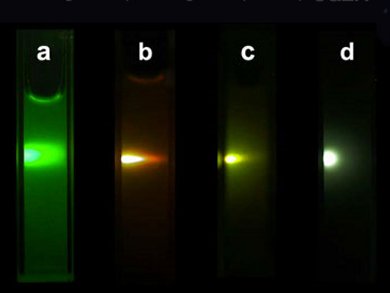Upconversion nanoparticles (UCNPs) doped with rare-earth elements have attracted interest as stains for biological imaging and even potentially as anticancer therapeutics. When irradiated with short-wavelength light such as ultraviolet light, most fluorescent molecules emit light at a longer wavelength, such as visible light. Upon excitation with long-wavelength, near-infrared light, UCNPs fluoresce at a shorter wavelength, in the visible spectrum. This makes them useful for imaging biological samples. Compared to short-wavelength ultraviolet light, near-infrared light can penetrate cells and tissues more efficiently, with less scattering, and less damage to cells.
Extreme conditions are necessary to synthesize UCNPs – 24 h at 300 °C in the absence of water and oxygen, for instance.
Chuanbin Mao, University of Oklahoma, Norman, USA, mixed acetates of the rare earth elements yttrium, ytterbium, and erbium, NH4F, and NaCl in the microwave at 160 °C for 1 h.
Experimental results showed that the microwave-assisted solvothermal method is an effective approach to create highly crystalline, strongly luminescent UCNPs. UCNPs with four different colors (green, yellow, orange and cyan) were successfully obtained. After being modified with amino groups and coupled with CEA-8 antibody, the obtained nanoparticles were successfully applied in the specific fluorescent immuno-labeling and imaging of HeLa cells to further verify their function as a marker in immuno-labelling.
Image © Langmuir
- Novel Microwave-assisted Solvothermal Synthesis of NaYF4:Yb,Er Upconversion Nanoparticles Their Application in Cancer Cell Imaging,
Cong-Cong Mi, Zhenhuang Tian, Can Cao, Zhijia Wang, Chuanbin Mao, Shu-Kun Xu,
Langmuir 2011.
DOI: 10.1021/la204015m




